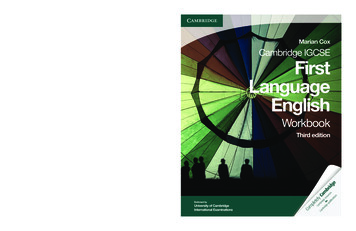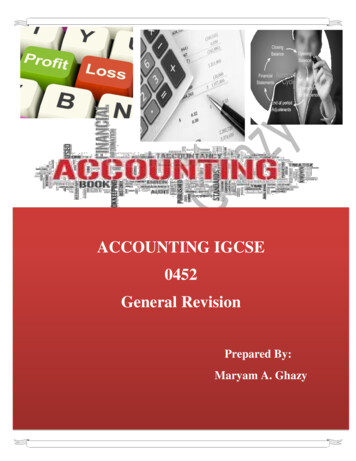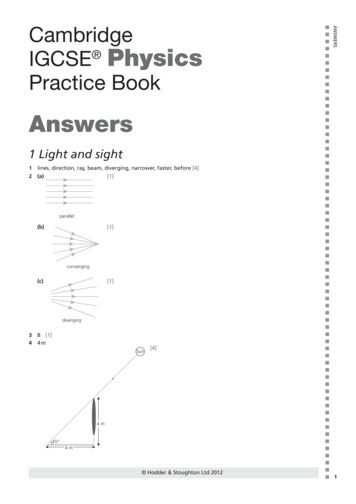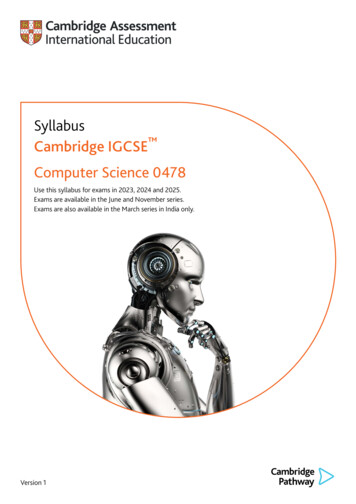
Transcription
Endorsed byUniversity of CambridgeInternational Examinations
ContentsIntroductionIVUnit 1The purpose of business activity1Unit 2Types of business activity5Unit 3Forms of business organisation10Unit 4Government14Unit 5OtherUnit 6Business costs and revenue23Unit 7Business accounting27Unit 8Cash flow planning32Unit 9Financing business activity36Unit 10Organisational structure41Unit 11Managing a business45Unit 12Comnlunication49Unit 13MotivationUnit 14Recruitment,Unit 15EmployeeUnit 16The InarketUnit 17Market research67Unit 18Presentation70Unit 19The nlarketing mix: product and packaging72Unit 20The marketing mix: price76Unit 21The marketing nlix: promotion79Unit 22The marketing mix: place83Unit 23Factors affecting production87U ni t 24Factors affecting location91U ni t 25BusinessexternalAnswersIndexand economic influences on businessinfluenceson businessin businessat worktraining1952and humanand employerresourcesassociations6064and nlarketingof informationin the international56conlnlunity9599110iii .
IntroductionHow to use the study guideThis text has pril11arily been written to support students in theirstudy of Business Studies to IGCSE. It has been designed tocomplementthe IGCSE Business Studies textbook (Borringtonand Stimpson). The units in this guide follow the chapters inthe textbook.Please be aware, however, that the order of the units in thetextbook and this study guide and the order of the sections of thecurriculum content are different.Teaching progra111nles do nothave to follow the order of either the curriculunlcontent in thesyllabus or the textbook.Teachers may have used the schenle ofwork provided on CIE's website, so again the order of the units inthis study guide will not be the same as the order of topics n thescheme of work, or the scheme of work provided on the CD-ROMwhich supports the textbook.- Curriculum ContentIGCSE SyllabusBusiness and the environment in which it operates:A - Business activityB - The organisation( - (hanging business environmentD - Economic environmentBusiness structure,AB- Ownership- FinancingandorganisationinternalIGCSEStudy Guide UnitsUnitsUnitsUnitsUnits1,1,4,1,2252, 25and control:Units 3,10,11,12Unit 9organisationbusiness activityBusinessactivityto achieve objectives:A- MarketingB-(-Production (Operations management)Financial information and decision-makingPeople in business:A - Human needs and rewardsUnits 16, 17, 18, 19,20,21,22Units 6, 23, 24Units 7, 8B - ManpowerUnit 13Unit 14Regulating and controlling business activity:A - Reasons for regulationB - Influences on business activityUnits 4, 5Units 4, 5, 15, 25The IGCSE Business Studies exanunation has two question papers.Paper 1 contains short-answer questions and structured questions basedon short pieces of information. The skills being tested are nlainlyknowledge with understanding and application, with fewer nlarksawarded for analysis and evaluation. The questions on this paper carryup to 8 marks, but most of the questions have 2, 3, 4, 5 or 6 111arksallocated. You will see in the different units in the study guide thereare these types of shorter-answer questions for you to practise.Paper 2 has a business situation or problel11 with questionsarising fronl the case study. The skills being tested on this paper areanalysis and evaluation, but the questions will be asking for theanswer to be applied to the business in the case study. Thequcstions on this paper often carry 8, 10 or 12 l11arks. Again, thereare questions in the different units in this book, which will helpyou to practise answering these types of questions.iv
. . . . . . . . . . . . . . . . . . . . . . . . . . . . . . . . . . . . . . . . . . . . . . . . . . . . . . .Introduction.Each unit in the study guide has the following five sections:SectionWhat the section coversHow to use the sectionKey objectivesOutlines the key objectives, whichspecify what you should understandor be able to do i the examination.These lists can serve as a checklist ofyour progress in each topic.Key definitionsSumma rises the main terms ordefinitions you should know forthe examination.These are only summaries (in theform of a table or diagram) and formore detailed explanation youshould add to these from yourtextbook or class notes.Sample questions and answersGives examples of studentanswers, outline mark schemes andexaminer's marks and comments.Cover up the examiner's marks andcomments and see what markyou would have given the answerbefore you look at the actual markthat was given. This will help youunderstand what is required forfull marks.Common misconceptionsGives some common mistakesmade by students in exams.and errorsTry thisHas examination questions foryou to answer.Answer the questions. The answerssection at the back of this revisionguide will help you to check themarks your answer would havereceived.This study guide contains the necessary support for theattainment of the highest grade. It can be used on its own or incombination as follows:. to conlplenlent the IGCSE textbook and CD-lz.OM. at the end of each topic, to provide reinforcelllent andassessnlent. to prepare for the IGCSE exanlination.If you want to get the maximumstrongly advised that you attemptpaper and not in the book. Thenintervals throughoutthe course.We hope you find this bookIGCSE Business Studies and thatcommendablegrade.value fro In this book, it isto answer all the questions onyou can repeat the exercises at.a useful resource in your study ofit assists you in gaining aWhat examiners are looking forMost Business Studies exanlinationskills. These are:papers are testing four different. knowledge with understanding. application. analysis. evaluation.Knowledgewith understanding.This is tested with the type ofquestion that asks you to explain a particular ternl, for exaInple,'What is Ineant by market segnlent?' These are the type of questionswhere you will need to have revised the temlS or definitions of thev8
.INTRODUCTION.different topics. You need to be able to write down what they nleanclearly and accurately if you are to gain nlaxinlunl n1arks. Withthorough revision of the definitions section and supporting notes itwill be relatively easy to acquire nlost of the nlarks for thesequestions. Unfortunately, only about a quarter of the marks acrossthe whole papers will be for knowledge with understanding.The type of command words which are testing this area are:Describe., State., List., Outline., What is nleant by.,Give., Define., Identify., Name.Application. This means the exanliner is testing whether you canapply your answer to the business given in the examination, forexample, 'What do you think the business in the case study could doto increase sales?' Your answer must not just be a general explanationof how a business could increase sales, but how this specific businesscould increase sales. If you don't try to think in temlS of the businessgiven, you will lose a quarter of the marks across the wholeexamination papers. So this is a very important skill.When you look at the revision questions in this book, you willsee that there are many mini case studies outlined before thequestions themselves so that you can practise this skill of answeringin the context of the particular business.The type of command words which are testing this area are:Explain how this business., Why might company x. ., Give anexample from the case study to., Why nlight COinpany z., Fron'}the case study outline.Analysis. The skill of analysis involves being able to selectinfom1ation from text, tables, graphs, diagranls or drawings. Youshould be able to arrange infom1ation in order to Illake sense of it, forexample, this could involve graphing infomlation provided in a table.You must be able to analyse what infomlation is being shown, forexample, if the infom1ation shows an upward trend in the businessperfom1ance. Or you must be able to exanline the implications of asuggested idea or strategy.There are evision sections thoughout this book that containquestions that give you practice of this skill.The type of command words which are testing this area are:Analyse two factors., Explain why., Using accounting ratios,analyse., Examine why the business.Evaluation.This skill requires you to draw conclusions, nlakejudgements or make recommendations, but they must be justifiedto ensure the marks are achieved, for exanlple, 'Which would bethe best form of finance for this business to use to pay for theexpansion of its {actory?' The question does not just test evaluationbut also tests knowledge with understanding, application and SOineanalysis. The mark scheme will reflect the different skills beingtested and reward thenl accordingly.Revision sections throughout this book contain questions thatgive you practice of this skill. Exanliner's tips will also indicatewhere you need to include evaluation in your answers. vi
.IntroductionThe type of con1mand words which are testing this area are:Discuss., Justify., Consider., Decide., Which., Evaluate.,Why do you think., To what extent., Do you agree.,Advise., Assess., Recomn1end.,.As you work through the questions in this study guide, try to thinkabout which skills the examiner is testing. For example, if theexaminer is testing evaluation by asking if you agree with aparticular proposal, then you must make judgementsin youranswer, so you should agree or disagree and explain why, otherwiseyou will not gain the higher marks.Preparing for the examinationDuring the coursePreparing for an external examination is a continuous processthroughout the course. All the activities, lessons, homework andassignnlents are major factors in detennining your finalexamination grade, so the first piece of advice is to suggest that youwork steadily throughout the one or two years of the course. It isessential that you prepare thoroughly for internal schoolexaminations then, as you approach the IGCSE exanlination andstart your revision programme, the topics will be familiar and thelearning process will be less stressful and more productive.Revision should be what it says, refreshing your menl0ry of whatyou need to know and be able to do for the exanlination; it shouldnot be learning something for the first time.Make sure that your notes are up to date. If you nliss workthrough absence either copy it from a friend or leave a conlnlentin your notes that will remind you to refer to the topic in atextbook. Similarly, look at any hon1ework you have missed and ifit involves the reinforcement of skills or concepts, then it would bea good idea to complete it.In sun1mary:.work throughout the courseensure that your work is both complete and accuratelearn the topics for tests and internal exanlinationsseek assistance if you find an aspect of the course difficult.Revision tips. Divide your time so that you revise a section or topic at a tilHe.You could do one unit from this guide at a tinle or you couldgroup units together into the topic areas, for exalnple, nlarketingwould include Units 16 to 22. Learn the terms, concepts, facts, etc. thoroughly. Precise andclear answers are more likely to gain full nlarks. Vague answersmay get son1e credit, but they are more likely to lose you Inarks. When you have learnt a particular topic practise answering thequestions at the end of the units to test if you have learnt all thevii.
.INTRODUCTION. . . . . . . . . . . . . . . . . . . . . . . . . . . . . . . . . . . . . . . . . .informationthoroughly.you explain in detail.Pay particularattentionto nukingsureRevision techniquesWell in advance of the examination, produce a revision tinletable forall your subjects. Be realistic - you must include time for relaxationand socialising. Then create a more detailed timetable for BusinessStudies to cover all the topics. Ideally, you ought to go through thecomplete course twice. Keep a checklist of the topics studied - it isencouraging to have a visual record of your progress.It is useful to have a syllabus, but not essential as this bookincludes all the infornlation required for IGCSE Business Studies.You will need a quiet room at a cOlnfortable telnperature, plentyof paper and a pencil or biro. Some students find using highlighterpens helpful. On occasions revising with a friend nlakes a welconleand useful change. You will have to discover for yourself thelength of time for which you can profitably study. This is a veryindividual characteristic and can vary fro In person to person - itmay be as little as 30 minutes or over an hour. Do not exceed youroptimum study time, break up the available time into studysessions and breaks. Introduce 'rewards' - when I have finished thissection of work I will.Revision must be active, so do not believe that just looking at abook is an effective way of learning. Your eyes can go over thewords but the meaning never enters your brain! You can nlakeflash cards that have bullet lists of essential points. You can studythe topic for several minutes and then close the book and write outwhat you can renlember - do not take great care over presentation- then check your account against the book. Repeat until youhave most of the information correct, then move on to anothersection of the work.This is the 'look, cover, write and check' technique and it is veryeffective for the majority of students. It is crucial that you repeat thistechnique on the same topic at least once, but preferably twice, soonafter your first attempt, i.e. either later the sanle day or the next day.Once you have acquired a reasonable knowledge of the course, itis time to extend the revision to practising on past papers. This is anlost valuable form of preparation because not only does it provide atest of the effectiveness of your revision but it also provides aninsight into what to expect in the 'real' examination. You need topractise the skills of application, analysis and evaluation. This requiresyou to look at case studies to answer questions. Paper 2 practicequestions, in particular, will develop these skills but Paper 1 will askquestions in a business context and also develop these skills.How to approach the examinationIf your Centre or school has provided a detailed exanlinationtinletable, highlight your examinations and put this tilnetable in aprolninent place in your home. Ask one of your parents to checkwith you each day so that you don't nliss an examination.viii
Introduction.Collect together the correct equipnlentthe night before pencil, pencil sharpener, eraser, ruler, calculator (are the batteriesOK?) and two blue/blackpens (in case one runs out).Leave honle in plenty of tilne. If you are late, you will not begiven extra tinle,. and under certain circunlstancesyou will not beallowed to enter the examinationroom. The regulations varydepending on the ExaminationBoard. Do not put yourself at adisadvantage.Advice for when you are about to take yourexternal examinations. Make sure you know the examination instructions. Read then1.on the front cover and obey thenl. Answer all the questions inthe examination as there is no choice given. Read each question carefully and pay particular attention to thecommand words. Highlight or underline the key words in thequestion. Make sure you obey the conlnland word, for exanlple,if the question says 'state two examples' then don't explainthem, but if it says 'explain.' then nlore than a siluplestatement is needed. Make sure you read a case study carefully and apply youranswers in the context of the case study. This is especiallyimportant in questions where you are specifically asked to do so. Use all the information provided in the case study. Read theinformation carefully and underline key points. Do not repeat the salue answer in different sections - you donot usually gain double credit. Use the nUlllber of lllarks available for a question as a guide tothe nunlber of points needed if you are not told how 111anytoinclude. Do not write a detailed answer to a question which isonly worth 2 marks. However, if luore marks are available thena detailed explanation will be needed. For questions using thecomnland words for analysis and evaluation then fewer pointswill be required, but more in-depth discussion will be neededfor the highest marks. Make sure you understand how to achieve the higher levels 011aquestion where a level response Inark schenle is used. These areusually the ones that are using the conlnland words for analysisand evaluation and carry a relatively large nUlnber of 111arks,forexanlple, 6, 8, 10, 12 marks. (Your teacher can explain this to you.). Be aware of the time available. Use your tinle wisely and don'tspend a lot of time trying to answer questions you are not sureabout. Answer the questions you are nlore confident inanswering and go back to the other questions at the end of theexamination. Also, if you have finished the exanlination beforethe end then re-read your answers and tlY to add to thenl. Ifyou run out of space then fill any space underneath the questionor answer on spare paper. Make sure the correct equiplllent is brought to the eX lll1il1ation,such as pen, ruler, pencil, eraser and calculator.ix .
INTRODUCTION.After the exalninationthe papers are sent to the exalniner allocatedto your Centre. This exanliner will be part of a tea In headed by aPrincipal Exanliner. All the nlenlbers of the exalnining tea111 willlook at a sample of their scripts and assess the range of candidates'responses to each question. About a week after the examination,the team will meet to co-ordinatethe marking for each questionand decide the range of responses that are acceptable. During thenlarking period, the Principal Examiner will sample the marking ofeach examiner, at least twice, to ensure conlparabilityof nlarkingacross the team. The scripts and the marks are returned to theExaminationBoard where the mininlunl mark for each grade isdecided. A few weeks later you are informed of your grade.How to improve your gradeHere are a few tips:. Use this book. It was written to help students attain high grades. Learn all the work. Low grades are nearly always attributable toinadequate preparation. If you can recall the work, you willsucceed and if you cannot, you will fail. Harsh, but true. Practise the skills necessary to be successful including calculationsand interpretation of graphs. Make sure you can explain your answers in detail and do notmake simple statements unless a question asks you for a simplestatement. Use past papers to reinforce revision, to become falniliar withthe type of question, and to gain confidence. Answer the question on the examination paper - do not regarda question as an invitation to write about the topic.Finally, good luck!ex
NIT 1 The purpose ofbusiness activityKey objectives.To understalid what is n1eant by scarcity. To know what is meant by the economic problem.To apply the idea of opportunitycost to a nUl11ber of differentsituationsTo explain why specialisation is important in modern businessesTo understand the nature of business activity and the groupsinvolved in itKey definitionsUnlimited human wantsThe economic problem is causedby the scarcity of resources(factors of production) comparedto human wantsScarcity results in opportunitycost. When choices are made,the next best thing given up iscalled the opportunity cost Scarcity of factors ofproduction: land, labour,capital and enterpriseLand - includes all naturalresourcesLabour - the number of peopleable to workCapital - man-maderesourcessuch as machines that aidproduction1You have 10 and want to buyboth a DVDand a jacket. If youbuy the jacket, the DVD is youropportunity costEnterprise-peoplepreparedtotake risks by starting e resources are used toconcentrate on producing oneparticular product.Countries specialise, e.g. Qatarin oil production. Labour withina firm can specialise, too.Division of labourEach worker does one specialised job.In a computer assembly factory eachworker will perform a specialist task.Business objectivesThe targets or aims that a business isworking towards.Increase profits, increase sales,survive. Objectives can differbetween businesses. The objectivesof anyone business can change overtime, e.g. survival at start-up andprofits once it is established.Value addedThe difference between the sellingprice of a product and the cost ofthe bought-in materials needed tomake it.If a firm sells a product for 15, butthe materials that were bought infrom other firms only cost 6,then the value added is 9.StakeholdersGroups of people with a directinterest in the performance of abusiness.Workers, customers, consumers,shareholders, residents, government,banks. These groups often havedifferent objectives for the business.1 .
UNIT 1.Sample questions and answersSarnplequestionThe AR.C COll1pany produces and sells cosnletics for wonlen andgirls. The con1pany is owned by a brother and sister. They wantedto lllake more n10ney than they were earning in their old jobs.Although profitable, business sales have fallen in recent years. Thisis causing 111any stakeholder groups to worry about the future ofthe business. The owners are very keen for the business tocontinue. Sales are falling due to new conlpetitionin the nlarketwith exciting new products, so ARC lllust cut productioncosts tosurvive. The con1pany has bought expensive new 111anufacturingequipment which is very specialised. Fewer workers are neededand they perform the same tasks each day and some workers haveleft because they are bored. Productionhas fallen as a result of thisand ARC cannot supply all of the shops.The marketing director is keen to increase the value added ofthe cosmetics. One product - the 'Bella' perfun1e - currently sellsfor 7. It is made from soap bought in by the business at a cost of 2 per item. The director believes that by designing new luxurypackaging for the product, value added could be increased.a) How do the business'srecently?objectivesseelll to have changed[5 IIIarks ]Marks1 mark for explaining what a business objective is; 2 marksfor identifyingand explaining the original objective; 2 marks for identifying andexplaining the more recent objective.answerMost businesses have objectives that they ain1 for. The objective ofthis business is to survive. It has a lot of new cOll1petitors and salesare 'llling. Stakeholders are worried that the business n1ight notsurvive so this is now the business's objective.Examiner'smarksand commentsThe student understands that objectives are targets to aim for - 1 mark.The answer states that the latest objective is probably survival and explai1l5why - 2 marks. However, there is no attempt to identify or explain theoriginal objective that seems to have been profit. 3/5 marks.Student'sb) Explain the advantages and disadvantages of using division oflabour for this business.[7 marks]Marks1 mark for explaining divisionif labour; 3more advantages for this business (maximumbusiness);3 marks for explainingbusiness (maximumStudent's. 2answer2 marksif nomarksfor explaining two or2 marks if 1tO riference to thistwo or more disadvantagesfor thisriference to this busilless).Division of labour is where a product is n1ade by workersspecialising on one stage of production each. The new machinerythat ARC bought allowed the business to use division of labour.This nleans that each worker does what they are best at. Thisshould increase output and ill1prove quality. ARC should benefitfrom lower costs and this will help the business survive. However,division of labour does have its problems. The work can be boringas workers are only doing one job all the tin1e.
The purposeof business activity.Trythis yourself-theto markexaminer's marks alld COII/II/flltsarc Oilpage 99.c) Assume that the marketing director bought in new packagingfor the Bella JPerfun1e. This costs an extra 1 per unit. Sheincreases the selling price by 20%. Calculate the new valueadded of this product.[3 marks]Marksifthe candidateno working;calculatesifthe correctnew bought-inStudent'sanswerValue added selling of 5. 40costs of 3 is statedif formulaprice of 8. 40 1 mark;mark.answer 3marks 1 mark;evenif new sellingof value added is correctly givcnprice less bought-inwith 1costs 7 20% less 3 8.40 less 3 5.40Examiner'smarksand comments3 marks - well done!d) Evaluate anyone alternative method that the Inarketingcould use to increase the value added of this product.Marksdirector[5 11larks]1 markfor identifyingone other method; 2 marks for cxplaillillg hOll)itmight increase value added; 2 marks for evaluating this method.Student'sanswerTo increase value added, the n1arketing director could keep theprice the san1e but lower bought-incosts. Cheaper Inaterials couldbe bought in for the perfun1e so that it does not cost so Inuch tomake. This will mean that value added fro In each bottle ofperfume will rise.However,cheaper materials 111ight lead to lower quality. Itn1ight nlake the perfume snlell differently. This could lead to fewersales of the product. If consumers are looking for a quality productin this market then sales could be hit badly.Tryto markare on page(:ommonthis answeryourself- the examiner'smarksalld comments99.misconceptionsanderrors.ErrorWhy it is wrong'More money will solve theeconomic problem.'The economic problem results fromscarcity of resources rather thanmoney.'Stakeholders are the sameas shareholders.'Shareholders are just one group ofstakeholders-there are othergroups, too.'Value added is the profit madeon each unit.'Value added is not profit as only thecost of bought-in materials/components have been subtractedfrom the selling price.3.
UNIT 1. TrythisA new plastics factory is to be built in your country. It will employ manyworkers and will export some of its output to other countries. It will be builton farmland several kilometres away from the main city. Other plasticsbusinesses are worried about the competition it will bring. It could lead tolower prices for plastic products. Local residents have mixed feelings aboutthe plan. The factory will use specialised equipment to allow for division oflabour.a)Identify four stakeholdergroups that will be affectedby the plan tobuild this new factory.[4 marks]b) Discuss how two of these groups might be affected by the new factory.[8 marks]Examiner's tip.I You ought to try to think of how stakeholders might be affected inboth positive and negative ways.c) Assess the effect on workers of using division of labour in thenew factory.Examiner's tip./ Define division of labour and consider both advantages and.disadvantages to workers.84[8 marks]
NIT 2 Types of businessactivityKey objectives88888Key definitionsTo know the difference between the three stages ofproduction: primary, secondary and tertiaryTo understand the difference between the private and publicsectors of industryTo explain the differences between horizontal, vertical andconglomerate mergers and takeovers.To understand the different ways of measuring business sizeTo explain why some businesses remain smallTypes of business mergers and takeovers (integration) - an exanlplefrom the oil industry:Vertical integration backwards iswith a business in the sameindustry but at a different stage ofproduction: towards the rawmaterial, e.g. integration withAsia Oil Fields picHorizontal integrationwill offer moreeconomies of scale andreduces average costsConglomerateintegration is alsoknown as diversificationConglomerateintegration is with firmsin a different industry,e.g. integration withNamibia Drinks picHorizontal integrationis with a business in thesame industry at thesame stage ofproduction, e.g. AstraOil picAcme Oil pic couldintegrate with otherbusinesses in thefollowing ways:Vertical integration forwards iswith a business in the sameindustry but towards theconsumer, e.g. integration withEgypt Petrol Stations picTermDefinitionExamplesPrimary productionIndustries that extract and exploitthe natural resources of the earth.Mining, agriculture, forestry andfishing.Secondary productionIndustries that manufacture goodsmade from the raw materialsprovided by the primary sector.Car production, computer assembly,food canning and steel making.Tertiary productionIndustries that provide services toconsumers and other sectorsof industry.Travel agents, banking, insurance,health services and transport.De-industrialisationRelative decline in the importanceof a country's secondary(manufacturing) sector.Most advanced industrialisedeconomies are experiencing this.58
UNIT 2.TermDefinitionExamplesPublic sectorThe sector of the economy in whi,horganisations are owned andcontrolled by the state (government).In most mixed economies, healthservices and railway services are inthe public sector.Private sectorThe sector of the economy in whichorganisations are owned andcontrolled by individuals.In most mixed economies, retailingand farming businesses are in theprivate sector.Free market economyAll resources are privatelyowned. Prices are determined bysupply and demand.There are no 'pure' free marketeconomies but the USAand SouthKorea, for example, have very largeprivate sectors comparedto the whole economy.Planned economyAll resources are owned by thegovernment,which also takesall major economic decisions.Former communist countriesEastern Europe had plannedcommand) economies.Mixed economyHas both a private and apublic sector.Ne
People in business: A - Human needs and rewards B-Manpower Regulating and controlling business activity: A - Reasons for regulation B- Influences on business activity Unit 13 Unit 14 Units 4, 5 Units 4, 5, 15, 25 The IGCSE Business Studies exanunation has two question papers. Paper 1 conta










